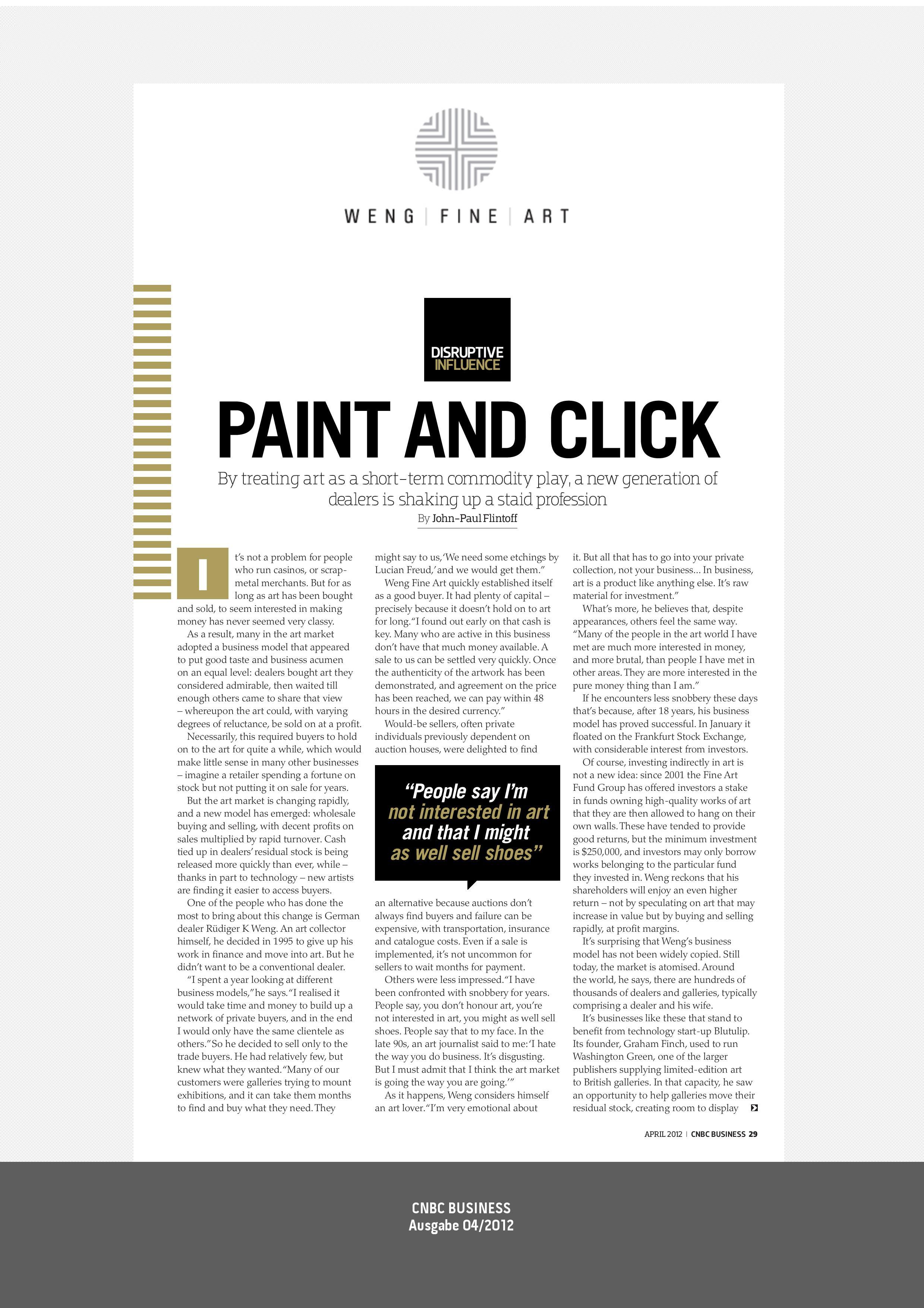News & Press
PAINT AND CLICK - By treating art as a short-term commodity play, a new generation of dealers is shaking up a staid profession
2 Apr. 2012 / Pressespiegel

It’s not a problem for people who run casinos, or scrapmetal merchants. But for as long as art has been bought and sold, to seem interested in making money has never seemed very classy. As a result, many in the art market adopted a business model that appeared to put good taste and business acumen on an equal level: dealers bought art they considered admirable, then waited till enough others came to share that view – whereupon the art could, with varying degrees of reluctance, be sold on at a profit. Necessarily, this required buyers to hold on to the art for quite a while, which would make little sense in many other businesses – imagine a retailer spending a fortune on stock but not putting it on sale for years. But the art market is changing rapidly, and a new model has emerged: wholesale buying and selling, with decent profits on sales multiplied by rapid turnover. Cash tied up in dealers’ residual stock is being released more quickly than ever, while – thanks in part to technology – new artists are finding it easier to access buyers. One of the people who has done the most to bring about this change is German dealer Rüdiger K Weng. An art collector himself, he decided in 1995 to give up his work in finance and move into art. But he didn’t want to be a conventional dealer. “I spent a year looking at different business models,” he says. “I realised it would take time and money to build up a network of private buyers, and in the end I would only have the same clientele as others.” So he decided to sell only to the trade buyers. He had relatively few, but knew what they wanted. “Many of our customers were galleries trying to mount exhibitions, and it can take them months to find and buy what they need. They might say to us, ‘We need some etchings by Lucian Freud,’ and we would get them.” Weng Fine Art quickly established itself as a good buyer. It had plenty of capital – precisely because it doesn’t hold on to art for long. “I found out early on that cash is key. Many who are active in this business don’t have that much money available. A sale to us can be settled very quickly. Once the authenticity of the artwork has been demonstrated, and agreement on the price has been reached, we can pay within 48 hours in the desired currency.
” Would-be sellers, often private individuals previously dependent on auction houses, were delighted to find an alternative because auctions don’t always find buyers and failure can be expensive, with transportation, insurance and catalogue costs. Even if a sale is implemented, it’s not uncommon for sellers to wait months for payment. Others were less impressed. “I have been confronted with snobbery for years. People say, you don’t honour art, you’re not interested in art, you might as well sell shoes. People say that to my face. In the late 90s, an art journalist said to me: ‘I hate the way you do business. It’s disgusting. But I must admit that I think the art market is going the way you are going.’” As it happens, Weng considers himself an art lover. “I’m very emotional about it. But all that has to go into your private collection, not your business... In business, art is a product like anything else. It’s raw material for investment.” What’s more, he believes that, despite appearances, others feel the same way. “Many of the people in the art world I have met are much more interested in money, and more brutal, than people I have met in other areas. They are more interested in the pure money thing than I am.” If he encounters less snobbery these days that’s because, after 18 years, his business model has proved successful. In January it " oated on the Frankfurt Stock Exchange, with considerable interest from investors.
Of course, investing indirectly in art is not a new idea: since 2001 the Fine Art Fund Group has offered investors a stake in funds owning high-quality works of art that they are then allowed to hang on their own walls. These have tended to provide good returns, but the minimum investment is $250,000, and investors may only borrow works belonging to the particular fund they invested in. Weng reckons that his shareholders will enjoy an even higher return – not by speculating on art that may increase in value but by buying and selling rapidly, at profit margins. It’s surprising that Weng’s business model has not been widely copied. Still today, the market is atomised. Around the world, he says, there are hundreds of thousands of dealers and galleries, typically comprising a dealer and his wife. It’s businesses like these that stand to benefit from technology start-up Blutulip. Its founder, Graham Finch, used to run Washington Green, one of the larger publishers supplying limited-edition art to British galleries. In that capacity, he saw an opportunity to help galleries move their residual stock, creating room to display new art and releasing cash. His research showed that 78% of galleries consider slow-moving stock to be a major problem. Finch is not the first to set up a website for galleries to open a ‘virtual’ shop and sell directly to art lovers around the world. There are many of those already, plus eBay (though few in the trade would trust such a generalist site). But Blutulip is the first, he claims, established special cally for
business-to-business transactions.
Why is this important? Because at a stroke it allows galleries to sell to each other’s customers. “There are big regional differences in demand for certain works and certain artists. It may be that a gallery in Brighton, for example, has sold out of a particular limited-edition print, but they still have demand for that print from their local customers. If that gallery goes back to the publisher, the likelihood is that that print will be listed as ‘sold out’ because all copies have been sold to trade. However, a gallery in Exeter may still have some of those prints available and may be having difficulty selling them to local consumers. Blutulip.com helps to match the supply and demand.” (The name of the dealer who’s selling is concealed until the purchase is made, to avoid any suggestion that they are struggling to sell in their galleries.)
Before setting up Blutulip, Finch spent a lot of time studying established fine-art portals, and other sites such as Etsy, where crafts enthusiasts buy and sell handmade goods. Blutulip was designed to ape Etsy’s simple design: users can easily search for art by subject, by price, by medium and by the name of the artist, once they have paid the £25 (€30) minimum monthly fee. To increase the potential audience for his site, Finch offers free membership to designers and architects who can buy art for slightly more than the trade price, but less than retail, providing them with an opportunity to increase their own margins when buying work for third parties.
Additionally, Blutulip offers membership to artists, to sell their work directly. In the past, artists who didn’t sell through a gallery might have been looked down on, rather like authors who self-publish, but that too has changed, since Damien Hirst bypassed his own dealers, Gagosian and White Cube, in 2008 to sell directly at auction. His intention was to open up the market, or as he put it: “To cut out the galleries, and take a whole load of boxfresh pieces straight to market, no strings, highest bidder wins. Bang!” Altogether 218 works were sold for a total of £111m.
Conventional wisdom is that only high-end artists like Hirst can sell directly to the public, but the music industry has shown that even entry-level artists can find a market. Thus, hobbyists and Sunday painters can sell through Blutulip. “Many artists find the commercial side takes them away from what they do best – creating art,” says Finch. It’s not uncommon for artists to leave their work with galleries on a sale-or-return basis, and galleries don’t always notify them of a sale: they’re expected to keep checking, which takes time and can be demoralising. “What we are allowing them to do instead is upload images of their art and instantly have an audience of hundreds of gallery owners.”
At least, that’s the idea, but Blutulip only launched in January. If it doesn’t attract a wide range of buyers and sellers quickly, it will fail – but then, the same could once have been said of eBay. At the time of writing, the site is selling works by Renoir, Picasso, Matisse, Henry Moore, Salvador Dalí, Jack Vettriano, Bob Dylan... and many others considerably less well known.
Art snobs might be appalled that there’s no barrier to entry – and it’s true that some ‘artists’ may try to sell work that lacks any redeeming merit. But that won’t necessarily stop it selling: many bestselling artists were once considered dreadful. And if artists consistently fail to sell, says Finch, they’ll find it hard to justify the membership fee.
Like Weng, Finch doesn’t ultimately care what kind of art is sold. The only thing that matters, from a business point of view, is that the art is genuine and can be resold afterwards. If buyers are unhappy, art can be returned, and in the event of fraud, sellers will be reported to the police.
With that security in place, Finch intends to start retail sales within a year, something Weng always avoided. “It can be dif! cult to wholesale and retail at the same time with the same goods,” says Weng. “If you supply to the clients of your clients, they probably won’t come to you any more.” Nor did he want to build up an expensive team to service retail clients. But in March, Weng launched a new company selling artworks in multiple editions to retail buyers.
CNBC BUSINESS | APRIL 2012 | VON JOHN-PAUL FLINTOFFF


